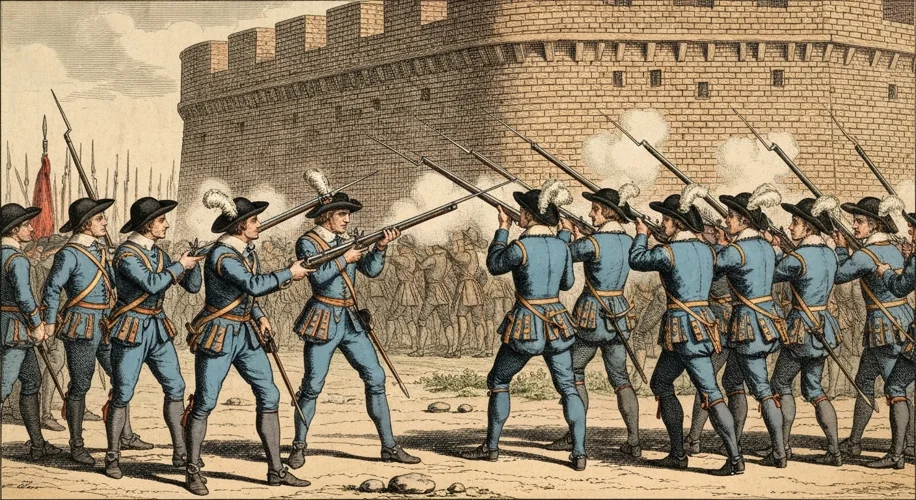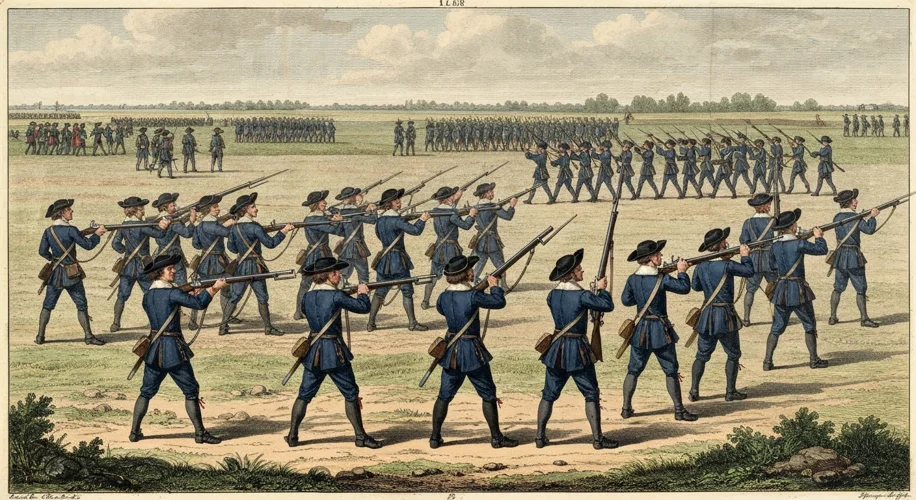Imagine the scene: : a battlefield in the 16th century. Soldiers, armed with matchlock muskets, stand in ragged lines. Loading their weapons is a slow, cumbersome process, taking what feels like an eternity. The enemy advances, a tide of steel and determined faces. When the order to fire comes, it’s a chaotic, uneven roar, with only a fraction of the muskets discharging effectively.
This was the reality of infantry combat for centuries. But on the horizon, a revolutionary tactic was brewing, one that would transform the battlefield from a chaotic brawl into a more disciplined, devastating display of firepower: the volley fire.
The Slow Grind of Pre-Volley Warfare
Before the advent of effective volley fire, infantry battles were often decided by close-quarters combat and the sheer shock value of a charge. Muskets, while capable of inflicting damage, were notoriously unreliable. Loading involved pouring powder down the barrel, ramming a lead ball, and priming the weapon with a slow-burning match. Even the most skilled soldier could take a minute or more to reload. This meant that a single rank of soldiers could only deliver one effective volley before needing to fall back and reload, leaving them vulnerable.
Adding to the chaos, individual soldiers would often fire their muskets as soon as they were ready, regardless of command. This sporadic, uncoordinated firing diminished the psychological impact and the sheer destructive power of the musketry. It was like a handful of firecrackers going off in a storm, rather than a thunderclap.
Enter the Innovators: Maurice of Nassau and the Dutch Republic
The stage for change was set in the late 16th and early 17th centuries, during the Eighty Years’ War (Dutch Revolt) against the Spanish Empire. The Dutch Republic, fighting for its independence, faced a formidable foe in the seasoned Spanish tercios – dense formations of pikemen and arquebusiers.
Maurice of Nassau, the Stadtholder of the Dutch Republic, was a keen student of classical military history. He observed the disciplined tactics of the Roman legions and sought to adapt them to the age of gunpowder. Alongside his cousin, William Louis of Nassau-Dillenburg, Maurice began to experiment with new drill and formation.

Their innovation was simple yet profound: the continuous reload. Instead of each soldier loading and firing independently, they developed a system where soldiers in successive ranks would fire, then immediately move to the rear to reload while the next rank stepped forward to fire. This ensured a constant stream of musket fire, creating a devastating and unbroken arc of lead that could chew through enemy formations.
The Birth of Disciplined Firepower
The execution of this tactic required immense discipline and rigorous training. Soldiers had to march in step, maintain formation under pressure, and meticulously follow the reloading sequence. Maurice of Nassau’s reforms introduced standardized drill manuals, emphasizing precision and cohesion. Soldiers were taught to load their muskets in a specific order, with each movement practiced until it became second nature.
The impact was immediate and profound. A well-drilled unit employing volley fire could deliver a sustained barrage of musket balls far more potent than the sporadic shots of uncoordinated infantry. The sheer volume of fire could shatter enemy morale, break charges, and inflict casualties at a rate previously unimaginable. The dense Spanish tercios, once the masters of shock tactics, found themselves vulnerable to this relentless, unseen enemy.
The Dutch Republic’s success on the battlefield, largely attributed to Maurice’s military reforms, quickly caught the attention of other European powers. Armies across the continent began to adopt and adapt the principles of volley fire. Frederick William, the “Great Elector” of Brandenburg-Prussia, further refined these tactics, creating an even more disciplined and mobile infantry force. By the late 17th century, volley fire had become the standard doctrine for most European armies.
The Long Shadow of the Volley
The implications of volley fire extended far beyond the immediate battlefield. It necessitated a more professionalized military, requiring standardized training, uniforms, and equipment. It also contributed to the rise of the nation-state, as centralized governments could more effectively raise, equip, and command larger, more disciplined armies.
The volley fire represented a fundamental shift in the art of war. It moved away from individual prowess and toward the collective might of organized firepower. It was the birth of controlled, systematic destruction, a precursor to the devastating artillery barrages and machine-gun fire of later centuries. The next time you see a depiction of soldiers firing in unison, remember the revolution that began with a simple idea: the disciplined, continuous delivery of firepower.

